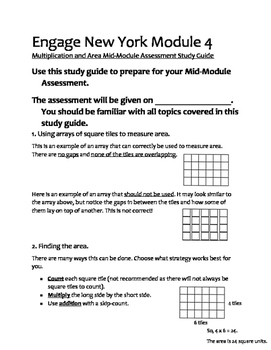3rd Grade Engage New York Math Study Guides & Practice Tests for All Modules
Flip Charts Galore
1.2k Followers
Grade Levels
3rd
Subjects
Resource Type
Standards
CCSS3.MD.A.1
CCSS3.NBT.A.1
CCSS3.OA.A.1
CCSS3.NF.A.1
CCSS3.G.A.1
Formats Included
- Zip
Pages
40+
Flip Charts Galore
1.2k Followers
Description
I made these study guides and practice tests to help prepare my students for the Engage New York 3rd Grade Math Mid-Module and End of Module Assessments.
One study guide for each assessment is included along with a practice test for each assessment.
I have uploaded the Study Guide and practice test for the Module 4 Mid-Module assessment so you can see a sample of what you are purchasing.
Must have for any teacher who uses Engage New York Math! Your parents will appreciate it too!
One study guide for each assessment is included along with a practice test for each assessment.
I have uploaded the Study Guide and practice test for the Module 4 Mid-Module assessment so you can see a sample of what you are purchasing.
Must have for any teacher who uses Engage New York Math! Your parents will appreciate it too!
Total Pages
40+
Answer Key
N/A
Teaching Duration
1 Year
Report this resource to TPT
Reported resources will be reviewed by our team. Report this resource to let us know if this resource violates TPT’s content guidelines.
Standards
to see state-specific standards (only available in the US).
CCSS3.MD.A.1
Tell and write time to the nearest minute and measure time intervals in minutes. Solve word problems involving addition and subtraction of time intervals in minutes, e.g., by representing the problem on a number line diagram.
CCSS3.NBT.A.1
Use place value understanding to round whole numbers to the nearest 10 or 100.
CCSS3.OA.A.1
Interpret products of whole numbers, e.g., interpret 5 × 7 as the total number of objects in 5 groups of 7 objects each. For example, describe a context in which a total number of objects can be expressed as 5 × 7.
CCSS3.NF.A.1
Understand a fraction 1/𝘣 as the quantity formed by 1 part when a whole is partitioned into 𝘣 equal parts; understand a fraction 𝘢/𝑏 as the quantity formed by 𝘢 parts of size 1/𝘣.
CCSS3.G.A.1
Understand that shapes in different categories (e.g., rhombuses, rectangles, and others) may share attributes (e.g., having four sides), and that the shared attributes can define a larger category (e.g., quadrilaterals). Recognize rhombuses, rectangles, and squares as examples of quadrilaterals, and draw examples of quadrilaterals that do not belong to any of these subcategories.




